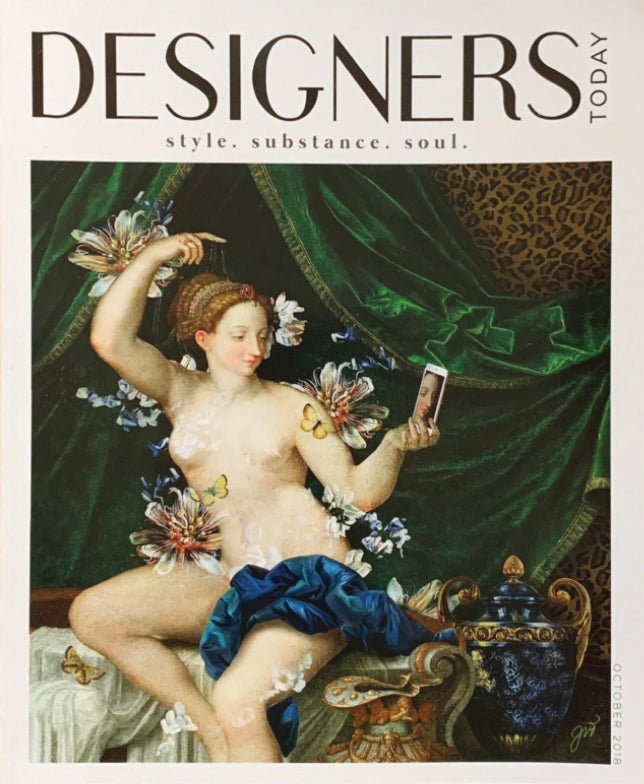How Long Does Peel and Stick Wallpaper Last?
There’s a common misconception that, because peel and stick wallpaper is designed to be easy to apply, it only comes in standard-looking patterns and doesn’t last very long. The truth is, like with any wall covering, there’s a range of different price points and levels of quality when it comes to removable wallpaper. The thickness of the material and the type of adhesive-backing really matters.
Most standard peel and stick options last for 5-7 years before they start to show wear and tear, but higher-quality wallpapers can last quite a bit longer. When you choose a well-made, premium peel and stick wallpaper and install it with the right technique, it can even last longer than a lesser-quality traditional wallpaper.
Benefits of Peel and Stick Wallpaper
If you’re trying to choose between peel and stick vs traditional wallpaper, you should consider your lifestyle, your home, and your unique needs. Traditional wallpaper may be a better choice for high-traffic areas, because it tends to be a little more resistant to wear and tear. It’s also sometimes preferable in bathrooms and other rooms that have higher levels of humidity.
But high-quality peel and stick wallpaper comes with many advantages too, including:
-
Ease of installation: Peel and stick wallpaper has an adhesive backing – like a sticker – so you can install it without the need for a separate paste.
-
Variety of patterns: These days, removable wallpapers are available in a huge array of different themes, patterns, and colors that can suit any personal style.
-
Renter-friendly: Peel and stick wallpapers tend to leave little-to-no residue behind when you remove them, which is why they’re so great for renters who can’t alter their walls.
-
Easy to maintain: With the right prep and application technique, peel and stick wallpaper is easy to care for.
Factors that Affect the Longevity of Removable Wallpaper
Application Technique
The best way to extend the life of your peel and stick wallpaper is to use proper installation techniques. Poor application can lead to air pockets, peeling edges, and uneven bumps.
When applying peel and stick wallpaper, be sure to start at the corners, work in smaller sections, and slowly secure it to the wall using a smoothing tool. This not only improves the longevity of your wallpaper, but it also ensures your design looks symmetrical and free of distortion.
Environment
Environmental factors play a huge role in how long your wallpaper will last. Generally speaking, extreme heat and humidity can have a negative impact on your wallpaper by interacting with the adhesion, causing peeling or even mold growth. Direct sunlight over an extended period of time can also cause the colors and patterns on your wallpaper to fade more quickly.
Fortunately, these environmental factors can usually be mitigated to increase the durability of your design. If you want to wallpaper a humid room such as a kitchen, bathroom, or laundry room, choose a moisture-resistant wallpaper and make sure the room is properly ventilated. You can also apply a vinyl top coat for extra protection and durability.
Underlying Wall Texture
Wallpapering textured walls comes with some extra challenges. Even subtle grooves and bumps on your wall surface will almost certainly make it more difficult to get a smooth and secure adhesion. That’s why you should smooth out textured walls before you apply your wallpaper.
If your wall only has minimal texture, it should be enough to go over it with standard sandpaper. More extreme textures with deeper grooves may require a more intensive process with a skim coating or joint compound.
Wallpaper Quality
The wallpaper itself can also have an impact on the longevity of your design. Make sure the wallpaper you choose is made of premium, water-resistant materials and has a strong adhesive backing. This will prevent peeling, fading, and deterioration, ensuring your design lasts as long as possible.
Peel and Stick vs Traditional Wallpaper: Which Lasts Longer?
Peel and stick wallpaper is easy to apply, comes in a wide variety of gorgeous styles and designs, and can last up to 10 years with proper care. But if longevity is your primary concern, then traditional wallpaper is probably your best bet.
While applying a traditional wallpaper is typically messier and more complicated, a high-quality product can last 20 years or more, especially if you use a good primer, glue, and top coat.
How To Make Peel and Stick Wallpaper Last Longer
Here are a few quick tips to help improve the lifespan of your peel and stick wallpaper:
-
Prepare your walls by cleaning and priming them before installing your wallpaper to get a secure adhesion.
-
If you have textured walls, sand them down before applying the wallpaper.
-
Use a smoothing tool during the installation process to make sure your wallpaper is free of gaps and bubbles.
-
Keep your space well ventilated by opening windows or turning on fans, especially in bathrooms and kitchens.
-
Clean your wallpaper with a soft, dry cloth. If you ever need to remove tough grime or dirt, you can use a small amount of mild soapy water and dry immediately after cleaning.
Not only will these tips make your wallpaper stick better for longer, but they can also keep it looking fresh for years to come.
Choose From Premium Peel and Stick and Traditional Wallpaper Designs and Elevate Your Space
If you want your peel and stick wallpaper to last, then you need to choose a high-quality wallpaper in a design you truly love.
At Mitchell Black, we offer an expansive range of peel and stick, traditional, and construction-grade wallpaper. Our wallpapers are made of high-end, premium materials and they come in diverse patterns and styles, helping you achieve your design goals in any space.
Want to learn more about our offerings and how you can get the most out of your peel and stick wallpaper? Schedule a complimentary consultation with our concierge service to speak with an expert today.







Leave a comment